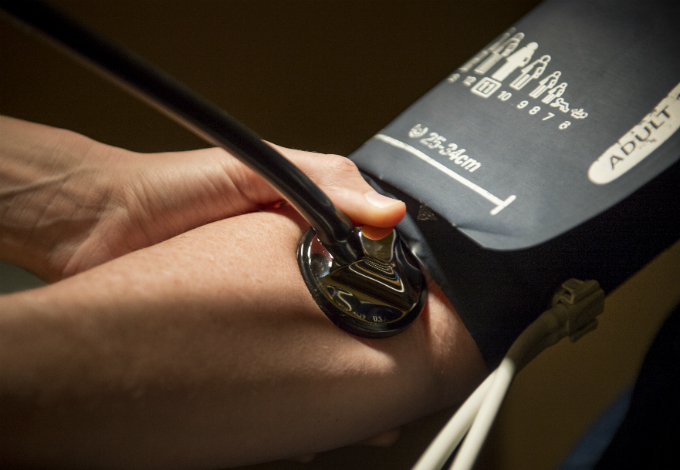The plans are among the nation’s best for quality and performance in 2023 Medicare Star Quality Ratings.

The innovative approach of Permanente Medicine to hypertension control is unprecedented.
Integrated Approach for Better Model to Hypertension Control
Permanente Care Teams Achieve Nation-Leading Results Through Coordinated Outreach, Treatment, and Follow-up
By Benjamin Seto
The Permanente Federation
Blood pressure is one of the most common vital signs to measure of patients, and how clinicians respond to the numbers has far-reaching implications to patients’ health and wellness.
One out of every three American adults has hypertension, according to the Centers for Disease Control and Prevention. Despite reasonably high rates of doctors getting those patients in for a recording of their blood pressure, fewer than half of patients have their high blood pressure under control, which puts them at greater risk of developing heart disease or stroke.
At Kaiser Permanente it’s a totally different story. Nearly 90 percent of our members who have a diagnosis of hypertension not only got a blood pressure check but also have their blood pressure under control. The difference stems from the fact that our solution isn’t limited to the classic one-to-one doctor-patient relationship or dependent upon a doctor working against a fee-for-service reimbursement paradigm.
Every doctor and patient at Kaiser Permanente are supported by processes and workflows developed through the leadership of physicians at the Permanente Medical Groups. They ensure regular checks and steps to provide a care and treatment plan if someone has hypertension – with each step of the process supported by a member of a robust care team that supports the physician.
“We’ve created a comprehensive approach to managing high blood pressure that includes our clinical assistants checking and re-checking a patient’s blood pressure to smart tools in HealthConnect (Kaiser Permanente’s electronic health record system) that enable the clinical assistant to take action and communicate with the patient’s PCP so patients have a care plan before walking out the door,” says Stacey Shapiro, MPH, RD, CPHQ, director of Population Care Management for the Mid-Atlantic Permanente Medical Group (MAPMG).
Top NCQA Rates
Kaiser Permanente’s Mid-Atlantic States Region has been so successful in helping patients control their blood pressure that it received the No. 1 rating for hypertension control in the 2016 National Committee for Quality Assurance’s Quality Compass® data report for commercial plans.
The integrated care model reflected in the practice of Permanente Medicine throughout Kaiser Permanente demonstrated effective hypertension control in all states where the health plan operates. Kaiser Permanente’s health plans in Northern California, Georgia, Colorado and Hawaii rounded out the top five plans in the nation in controlling high blood pressure, out of nearly 350 health plans considered, according to the Quality Compass report. The remaining two Kaiser Permanente regions – Southern California and Northwest – were among the top 10 plans for hypertension control.
We can’t point to just one approach that has made us successful. It’s about having several interventions in place, with different members of the team playing unique and important roles in providing that care.
— Kelly Kawaoka, MD, medical director for Population Care, HPMG
The Hawaii region is also No. 1 in hypertension control for all Medicare plans in the nation, while the other Kaiser Permanente regions were all among the top 10 for Medicare plans.
“We can’t point to just one approach that has made us successful,” says Kelly Kawaoka, MD, medical director for Population Care at the Hawaii Permanente Medical Group. “It’s about having several interventions in place, with different members of the team playing unique and important roles in providing that care.”
At Kaiser Permanente Hawaii, for example, scheduling follow-up appointments and doing a second check on members with elevated blood pressure are key to ensuring proper diagnosis and documentation in the health record. A hypertension workgroup influences the process in place for blood pressure checks and seeks opportunities to standardize workflows across the care delivery system.
Coordinated Follow-up and Outreach
Shapiro of MAPMG says constant reporting and continuous review on processes to ensure blood pressure results are acted upon by physicians and assessed by leadership teams for process improvement.
Other ways Permanente Medicine helps Kaiser Permanente members control hypertension include the following:
- If high blood pressure is detected during a specialty care visit, an appointment is made for a subsequent primary care visit, or a primary care physician follows up with a phone call.
- Outreach is a regular practice, especially to members who have not visited a doctor’s office for a while. This can include secure emails or phone calls, and alerts displayed on a patient’s personal online health record. In Hawaii, a special birthday card is sent as a friendly reminder of which preventive care checkups – including blood pressure checks – may be overdue.
- In Hawaii, Patient Support Service care managers monitor patient touches, including when a prescription refill is ordered. As part of the refill process, pharmacists check the member’s health record to see if preventive checks, such as blood pressure reading, is overdue and then arrange for patient follow-up.
- Several regions ensure there is access to blood pressure checks, including holding blood pressure clinics or providing appointments for blood pressure checks at locations such as Urgent Care facilities.
Model of Hypertension Control
The Permanente approach to hypertension control is serving as a leading model for other health care providers. The successful practices of The Permanente Medical Group in Kaiser Permanente’s Northern California Region were outlined in an essay last year in the Journal of Clinical Hypertension.
“Governments and hypertension organizations should promote the Kaiser Permanente hypertension program as a model to encourage clinics to adopt similar approaches,” wrote Mark L. Niebylski, PhD, chief executive officer of the World Hypertension League, in an introduction to the essay.
Crystal Tsuda, supervisor for Patient Support Service at Kaiser Permanente Hawaii, says the partnership between Permanente physicians and the clinics’ staff, along with continuous process improvement, contributed to the region’s No. 1 NCQA rating. But while the No. 1 rating is a significant achievement, it isn’t the main goal of the work.
“Our goal is not to seek out the No. 1 rating,” she says, “but to provide great care to our members so they can lead healthier lives.”
The source for data contained in this publication is Quality Compass® 2016 and is used with the permission of the National Committee for Quality Assurance (NCQA). Quality Compass 2016 includes certain CAHPS data. Any data display, analysis, interpretation, or conclusion based on these data is solely that of the authors, and NCQA specifically disclaims responsibility for any such display, analysis, interpretation, or conclusion. Quality Compass is a registered trademark of NCQA. CAHPS® is a registered trademark of the Agency for Healthcare Research and
Quality (AHRQ).


